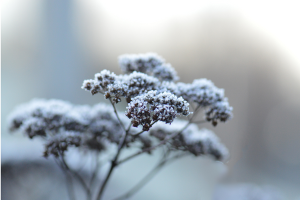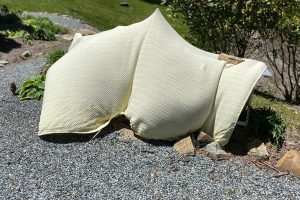
With three days of hard freeze already this winter and another weekend of freezing temps ahead, our gardens need us to brush up on frost protection.
When does frost occur?
Frost, which is a layer of ice crystals, is formed when water vapor on a plant condenses and freezes without first becoming dew. The temperature does not have to go to freezing or below for frost to occur. Frost can occur when the temperature is 36 degrees or below and wind and sky cover is favorable. Clear skies and a calm wind plus a temperature at 36 degrees or below contribute to the formation of frost.
Dew point also enters into consideration. The easiest way to tell if we are going to have frost or a freeze is to watch local news/weather forecasts. Our local meteorologists are very good about giving frost or freeze warnings. I recommend watching rather than listening to a local forecast, because area weather maps are shown. Frequently the area near the river and ocean are warmer than the official Jacksonville airport forecast. Sometimes there is no frost or freeze east of the river.
Microclimates: It could be different at your house.
Another thing to consider is microclimates, especially in Duval County where there is such variety in home sites. Land near the ocean and river or other large bodies of water can moderate the temperature as the water is warmer than the air temperature. Most of our area is pretty flat, but cool air settles in low spots of the landscape. Frost protection becomes critical further inland and in lower lying areas.
Trees Help. Again.
Tree coverage also prevents frost from settling on plants below them. That’s why you will frequently see tropical plants below a live oak undamaged by frost. The tree coverage reflects heat rising from the soil back down. There have been maps with a frost-free circle in downtown Jacksonville! All that concrete absorbs heat during the day and releases it at night. It might not feel warmer to you, though, as wind blows between tall buildings, but those plants need less frost protection.
Study your landscape for these microclimates. Potted plants placed in front of your sliding glass doors under a porch overhang, may be protected enough. Evergreen trees, like live oaks and southern magnolias may protect the plants below them. Master gardens often claim their succulents in pots below a sabal palm have not succumbed to frost or freeze damage. (This is a medium height properly pruned palm with more than a full half circle of foliage.) There are microclimates near your house, next to warm brick walls, where only the outside edge of a tropical shrub is damaged.

Frost Protection Weapons.
If you drive around town the morning after a frost or freeze, you will probably see what looks like people’s laundry on top of plants. A lot of people will just use old sheets and blankets to cover their tropical plants. You can buy landscape frost blankets, though. Ideally the fabric should be held above the plant by a frame of wire or bent plastic pipe. It should go all the way to the ground to trap heat under the cover. Use bricks or landscape pins to hold it down. Place the cover over the plant before dark and remove it by midmorning. Don’t use plastic covers. Foliage touching the cold plastic will be damaged and if you forget to remove the plastic in the morning, the sun will cook the plants underneath.
Frost Dates for Jacksonville.
Our median first freeze of 32 degrees is Nov. 21 or later. We can get hard freezes on occasion. A hard freeze is four consecutive hours of air temperatures that are below 28 degrees. We don’t get hard freezes very often, but when one is predicted, you may want to add a source of heat under the cover. An old incandescent light bulb will add a little warmth. Be careful that it doesn’t touch anything that could catch fire.
Water Ahead Not On the Day.
Moist soil also holds more heat. Water the soil a day or two before the forecast freeze. Do not use sprinklers running overnight during a freeze. The ice will damage your plants. Commercial growers know how to control the sprinklers during a freeze.
Citrus.
If a hard freeze is predicted, you may want to protect the graft union of citrus trees, by piling clean builder’s sand above the graft. Pipe insulation on the trunks of small trees is another option. Remember to remove this protection when the weather warms up.
Established citrus trees can withstand light freezes with no problems. Their fruit gets sweeter with cool weather. The fruit keeps better on the tree, so don’t pick unless a hard freeze is predicted. Otherwise just pick the fruit as you use it.
Tropicals.
Many of our tropical plants will act like herbaceous perennials when frozen. Since our ground doesn’t freeze, their roots and sometimes their lower stems don’t freeze. If your tropical plants do freeze, don’t remove the frozen leaves and stems before spring. The dead stems and foliage will protect lower portions of the plant. Consider dry pine needles piled up among the lower stems to protect a tropical plant.
Some plants are annuals, like marigolds and warm weather vegetables, and are not worth protecting. They are already in decline with the cool weather. Plants like crinum lilies, gingers and cannas have tuberous roots and bulbs that will survive our cold spells. You can remove damaged foliage of these and lightly mulch the soil. If you don’t want to have to cover tropical plants for a freeze, plant native plants or hardy plants in your landscape.
_________________________
This article was written by Master Gardener Brenda Daly and first appeared in the Florida Times Union.
 1
1
